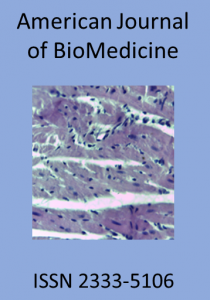Abstract
In the United State, lung cancer remains the leading cause of cancer death in both men and women. Several reports have suggested a role for estrogens in the development and/or progression of lung cancer, especially in women. Data from the national SEER registry between the years of 1990-2011 was analyzed, women between the ages 31-50 years old were chosen as representative of the premenopausal group (n=1595) and 51-70-year-old women represented the postmenopausal group (n=7075) as defined by the American College of Obstetricians and Gynecologists. For comparison, men were divided into two categories: younger men (n=2233) aged 31- 50 years and older men (n=10908) aged 51-70 years. Survival rates were analyzed by Kaplan-Meier method and compared by Z-test through SEER*Stat software version 7.0.9. The adenocarcinoma had a significant difference between premenopausal and postmenopausal groups (62% vs. 51%) respectively. Furthermore, the survival rate in premenopausal inferior to postmenopausal women in both SCC and BAC P<0.05. Premenopausal women more commonly underwent curative surgery, 42%, and 19% of postmenopausal women treated palliative. Additionally, for every stage of disease, 55% of postmenopausal women have radiotherapy. The results suggest varying estrogen effects between the histology sub-types of NSCLC and support clinical strategies need to block the ER pathway for the treatment of NSCLC.
Keywords: NSCLC; SEER; Estrogens; Premenopause; Postmenopause; Survival rate
Copyright © 2014 by The American Society for BioMedicine and BM-Publisher, Inc.
References
- Jemal, Ahmedin, Rebecca Siegel, Jiaquan Xu, and Elizabeth Ward. "Cancer statistics." CA: a cancer journal for clinicians 2010;60(5): 277-300. [Search Google Scholar]
- Radzikowska E, Glaz P, Roszkowski K. Lung cancer in women: age, smoking, histology, performance status, stage, initial treatment and survival. Population study of 20,561 cases. Ann Oncol 2002;13:1087–93. [Abstract/FREE Full Text]
- Thun MJ, Lally CA, Glannery JT, Calle EE, Flanders WD, Heath CW. Cigarette smoking and changes in the histopathology of lung cancer. J Natl Cancer Inst 1997;89:1580–6. [Abstract/FREE Full Text]
- Stabile LP, Lyker JS, Gubish CT, Zhang W, Grandis JR, Siegfried JM. Combined targeting of estrogen receptor and the epidermal growth factor receptor in non-small cell lung cancer shows enhanced antiproliferative effects. Cancer Res 2005;65:1459–70. [Abstract/FREE Full Text]
- Stabile LP, Davis AL, Gubish CT, et al. Human non-small cell lung tumors and cells derived from normal lung express both estrogen receptor α and β and show biological responses to estrogen. Cancer Res 2002; 62: 2141–50. [Abstract/FREE Full Text]
- Levin ER. Bidirectional signaling between the estrogen receptor and the epidermal growth factor receptor. Mol Endocrinol 2003; 17: 309–17. [Abstract/FREE Full Text ]
- Selvaggi G, Novello S, Torri V, et al. Epidermal growth factor receptor overexpression correlates with a poor prognosis in completely resected non-small-cell lung cancer. Ann Oncol 2004; 15: 28–32. [Abstract/FREE Full Text]
- Klapper LN, Kirschbaum MH, Sela M, Yarden Y. Biochemical and clinical implications of the ErbB/HER signaling network of growth factor receptors. Adv Cancer Res 2000; 77: 25–79. [Medline]
- Omoto Y, Kobayashi Y, Nishida K, et al. Expression, function, and clinical implications of the estrogen receptor β in human lung cancers. Biochem Biophys Res Commun 2001; 285: 340–7.[CrossRefMedline]
- Muscat JE, Wynder EL. Lung cancer pathology in smokers, ex-smokers and never smokers. Cancer Lett 1995; 88: 1–5. [Medline]
- Townsend EA, Miller VM, Prakash YS. Sex differences and sex steroids in lung health and disease. Endocr Rev 2012; 33: 1–47. [Medline]
- Henderson BE, Feigelson HS. Hormonal carcinogenesis. Carcinogenesis 2000; 21: 427–433. [Abstract/FREE Full Text]
- Deroo BJ, Korach KS. Estrogen receptors and human disease. J Clin Invest 2006; 116: 561–570. [Medline]
- 14.Yousif NG , Al-Matwari M. Overexpression of Notch-1 induced tamoxifen resistance through down regulation of ESR1 in positive estrogen receptor breast cancer. Journal of clinical oncology 2012; 30(15). [Abstarct]
- Hall JM, Couse JF, Korach KS. The multifaceted mechanisms of estradiol and estrogen receptor signaling. J Biol Chem 2001; 276: 36869–36872. [FREE Full Text].
- Patel UQ, Clemencet GV, Latruffe CB, Reddy PA, Chu Q, Heyman CJ, Griffin AE. Role of peroxisome proliferator activator receptor-gamma (PPAR-γ) in lung sepsis. American journal of BioMedicine 2014; 2(3): 270–291. [FREE Full Text]
- Hershberger PA, Vasquez AC, Kanterewicz B, Land S, Siegfried JM & Nichols M Regulation of endogenous gene expression in human non-small cell lung cancer cells by estrogen receptor ligands. Cancer Research 2005; 65:1598–1605. [PubMed]
- Kaiser U, Hofmann J, Schilli M, Wegmann B, Klotz U, Wedel S, Virmani AK, Wollmer E, Branscheid D, Gazdar AF et al. Steroid-hormone receptors in cell lines and tumor biopsies of human lung cancer. International Journal of Cancer 1996; 67: 357–364. [PubMed]
- Wilson CM & McPhaul MJ. A and B forms of the androgen receptor are expressed in a variety of human tissues. Molecular and Cellular Endocrinology 1996; 120: 51–57. [PubMed]
- Muscat JE & Wynder EL. Lung cancer pathology in smokers, ex-smokers and never smokers. Cancer letters 1995; 88(1):1–5. [PubMed]
- Parkin DM, Bray F, Ferlay J & Pisani P. Global cancer statistics, CA: A Cancer Journal for Clinicians 2002; 55:74–108. [PubMed]
- Schwartz AG, Wenzlaff AS, Prysak GM, Murphy V, Cote ML, Brooks SC, Skafar DF & Lonardo F. Reproductive factors, hormone use, estrogen receptor expression and risk of non small-cell lung cancer in women. Journal of Clinical Oncology 2007; 25: 5785–5792. [PubMed]
- Ahrendt SA, Decker PA, Alawi EA, Zhu Yr YR, Sanchez-Cespedes M, Yang SC, Haasler GB, Kajdacsy-Balla A, Demeure MJ & Sidransky D. Cigarette smoking is strongly associated with mutation of the K-ras gene in patients with primary adenocarcinoma of the lung. Cancer 2001; 92:1525–1530. [PubMed]
- Yokota J & Kohno TMolecular footprints of human lung cancer progression. Cancer Science 2004; 95:197–204. [PubMed]
- Devesa S. S., W. J. Blot, B. J. Stone, B. A. Miller, R. E. Tarone, and J. F. Fraumeni, Jr. Recent cancer trends in the United States. J. Natl.Cancer Inst 1995; 87:175. [PubMed]
- Au JSK, Mang OWK, Foo W, Law SCK. Time trends of lung cancer incidence by histologic types and smoking prevalence in Hong Kong 1983-2000. Lung cancer 2004; 45:143-152. [PubMed]
- Mark Karindas. The “Multicellular Origin” of Cancer and the Clonal Evolution of Oncogenesis. American journal of BioMedicine 2014; 2(1): 1-14. [FREE Full Text]
- Mollerup S, Jorgensen K, Berge G, et al: Expression of estrogen receptors alpha and beta in human lung tissue and cell lines. Lung Cancer 2002; 37:153-159. [PubMed]
- Adami HO, Persson I, Hoover R, et al: Risk of cancer in women receiving hormone replacement therapy. Int J Cancer 1989; 44: 833-839. [PubMed]
- Weiss JM, Lacey JV Jr, Shu XO, et al. Menstrual and reproductive factors in association with lung cancer in female lifetime nonsmokers. Am J Epidemiol 2008; 168:1319–1325. [PubMed]
- Brundage MD, Davies D, Mackillop WJ: Prognostic factors in non-small cell lung cancer: A decade of progress. Chest 2002;122:1037-1057. [PubMed]
- Gasperino J, Rom WN: Gender and lung cancer. Clin Lung Cancer 2004; 5: 353-359. [PubMed]
- Vincent RG, Takita H, Lane WW, Gutierrerz AC, Picken JW.Surgical therapy of lung cancer. J Thorac Cardiovasc Surg 1976; 71:581–591. [PubMed]
- O’Connell JP, Kris MG, Gralla RJ, et al. Frequency and prognostic importance of pretreatment clinical characteristics in patients with advanced non small cell lung cancer treated with combination chemotherapy. J Clin Oncol 1986; 4:1604–1614. [PubMed]
- Ramalingam, S, Pawlish, K, Gadgeel, S, et al Lung cancer in young patients: analysis of a SEER database. J Clin Oncol 1998;16:651-657. [PubMed]
- Bouchardy C., Fioretta G., De Perrot M., Obradovic M., Spiliopoulos A. Determinants of long term survival after surgery for cancer of the lung: a population-based study. Cancer 1999; 86:2229-2237.
How to cite this article
Yousif NG, Christian Schumann C. Differences in the survival rate between premenopausal and postmenopausal women with lung cancer: US SEER database. American Journal of BioMedicine 2014;2(4):193-199




